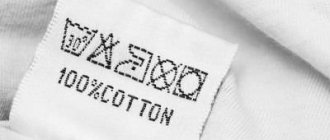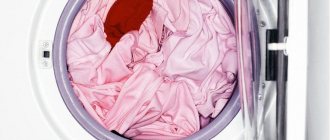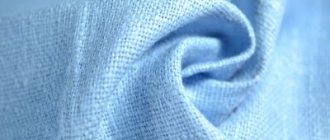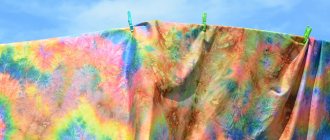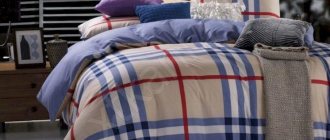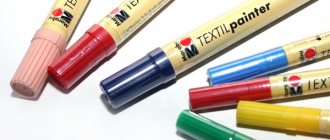Clothing is the calling card of every person. Beautiful, neat, stylishly dressed people always attract the eye. But in order to always look perfect, without needing to constantly update your wardrobe, you need to be able to properly care for things. This is especially true for washing delicate fabrics. Things with such a composition are extremely finicky. The slightest carelessness will result in damaged clothes. Therefore, we have collected basic recommendations for the proper care of products made from delicate fabrics.
What is and features of delicate washing
This concept occurs in two cases:
- when working with a washing machine, we are talking about the control lever;
- when studying a clothing label, it refers to the badge.
In both options, this means the washing mode. You can select it with a button when using an automatic machine or by setting the settings manually. Work with things is carried out according to one scenario. It is formed from the peculiarities of handling “fragile” tissues.
Delicate material loses its shape and color during standard cleaning. The time it remains in the drum in delicate mode is reduced to an hour. His movements become smooth. The minimum water heating is set and its quantity increases. Spin is set to minimum or disabled. The number of revolutions should not exceed 800. Drying and ironing should be turned off.
When manually spinning, wet items move into the basin. When the liquid has drained, tie it in a towel, wring it out and lay it out on a flat surface.
This will reduce the degree of mechanical impact on the fabric fibers and ensure gentle care.
This is interesting: Capitonium fabric: what kind of fabric is it in terms of composition, types, use
When it's needed
We use delicate or gentle washing when the fabric from which the clothes are made requires it. Washing in this mode avoids shedding. Does not harm fine fibers. With it you don’t have to worry that the color of the item will lose its brightness. Of course, all these factors are possible subject to certain rules for the washing process.
The delicate mode is used for certain fabrics.
Preparatory stage
Before you begin, you need to properly prepare things:
- The clothes are turned inside out.
- Since the bottom of the product and the sleeves can stretch out during wet processing, they should be protected by threading a needle or any other strong and non-fading thread and stitching the problem areas along the edge with wide stitches. Pair the thread only after the product has completely dried.
- Are your clothes stained or heavily soiled? This means that before washing, they soak it - pour cool water into a basin, generously soap the problem areas, and leave for 20 minutes.
- Before washing knitted items, you should carefully study their label: items made from natural fabrics are washed in water at a temperature no higher than 40-50°C, those made from synthetic fabrics - up to 40°C. Do not wash with hot water, as high temperatures may cause the product to shrink.
Selecting a detergent
It is not recommended to use regular washing powder for washing knitwear - it does not rinse well, and delicate fabric may become damaged after contact with it. Several means are acceptable:
- Soap solution. Laundry soap is rubbed on a fine grater and the shavings are dissolved in water.
- Gel for washing delicate fabrics.
- Shampoo. If you don’t have a special product at hand, you can use any hair shampoo.
- Hard water can deteriorate the appearance of a knitted product; to soften it, use baking soda - about 1 teaspoon will be needed for a medium-sized basin.
- Do not use bleach for knitwear. If it is necessary to make the item white, after washing it, rinse it in water with the addition of a small amount of hydrogen peroxide. A couple of tablespoons of salt or vinegar will help return faded fabric to its rich color - they are dissolved in a bowl of water when rinsing.
How long does it take to rinse in a washing machine?
The time it takes to rinse depends on the options selected. How many rinses are needed is decided either by the machine itself (the manufacturer) or by the user. The laundry needs to be rinsed thoroughly, and you cannot skimp on this. If the user considers it necessary, he sets an additional rinse, which will increase the cycle by 20–30 minutes.
On almost all brands of SMA, rinsing is indicated by the same icon - a basin with a wavy line or straight lines. Rinsing is one of the main steps. On many machines, the “rinse” button is even located separately. When rinsing, the water is automatically drained. The duration depends on the brand and model of SMA. One rinse may take 10–30 minutes.
Features of delicate washing
Delicate wash is a special mode for washing fabrics that need careful handling, characterized by a reduced number of revolutions without spinning in a centrifuge and an increased water level. It allows you to extend the life of your things.
What does the delicate wash cycle include?
- A large amount of water in the tank is necessary to minimize mechanical stress on the fabric.
- Low temperature up to 40°C reduces the shedding of linen and prevents it from staining.
- Smooth and slow movements of the drum will not cause harm to tissues.
- There is no spinning of clothes on washing machines; sometimes it is activated on some models, but with speed reduced several times.
- There is no drying function.
But it's not that simple. Equipment manufacturers understand the term “delicate washing” differently. Some models are gentle only on wool and silk , while on others this mode is intended exclusively for cotton. In order not to make a mistake and not to put your things at risk, you need to study the instructions indicating the necessary parameters.
What fabrics are suitable for delicate washing?
A label on the back of the garment will indicate whether the item needs to be treated with care. In its absence, there are rules for which fabrics a special regime applies:
- artificial: viscose, elastane, lycra, polyester;
- natural: wool and silk.
In addition, if the fabric is rich in color and has many details in the form of buttons, ruffles , then it is always washed in a gentle mode. This also includes lace products.
What if there is no such regime?
It happens that there is no delicate wash on the program selection panel in the washing machine. This happens at several points.
The mode is considered redundant, since the machine contains additional programs, in addition to the standard ones, designed for washing wool, silk, and delicate fabrics. It is believed that this is enough.- According to manufacturers, hand washing is similar to delicate washing. Therefore, if the first mode is present in the machine, then it presupposes a careful attitude towards things.
If such a program is still not available, then simple steps are taken independently for delicate washing .
- The temperature does not exceed 40 o C.
- Spin mode is disabled.
- Washing takes place in special bags - meshes to prevent deformation of things.
What means can be used?
For items that require care and protection during washing, special detergents are used. In order not to get confused in the variety of powders and conditioners, those that have a special mark on how to treat things with care are selected. Universal products are excluded, and the choice is made in favor of those that do not contain aggressive components, phosphates, chlorine, which damage tissue.
For gentle washing, it is best to choose liquid detergents that dissolve in water and are completely washed out of fabrics.
They do not cause allergies, remove stains and wash well. Things retain their original color. Thanks to the presence of lanolin and other softening components, the product will not lose its shape. The product is biodegradable without harming nature.
What does a full cycle consist of?
The sequential execution of the usual stages - washing, rinsing and wringing out things - constitutes a full cycle of operation of the machine. The device allows you to regulate the specifics of these operations.
Wash
The choice of washing mode is determined by the following parameters:
- fabric structure;
- the presence of decorative elements on products;
- contamination (you can include soaking, boiling cotton fabrics).
The right choice will determine not only how well things are washed, but also possible damage to the laundry from the aggressive effects of temperature and high speeds.
Rinsing
When rinsing, detergents are washed out of fabrics. Many people prefer to run an additional rinse mode to thoroughly wash the laundry from powder.
Spin
Choosing the right spin is the key to easy and enjoyable ironing. Only cotton fabrics should be spun at high speeds. Linen, silk, and synthetics should not be wrung out too much so as not to damage the fabric and make ironing easier.
What things require gentle care?
Delicate washing is the gentle cleaning of items from dirt at low drum speeds and at low temperatures. The mode is intended for thin and stretchable material, which is easily damaged during operation of the machine, and especially during spinning. If you run a standard program, capricious things may lose their shape and volume. The bright colors will fade, and pills and puffs will appear on the clothes.
Delicate fabrics are materials made from “fragile” fibers that require special care. It must be handled with care, otherwise distortion, thread breakage, or shrinkage of the product may occur.
Delicate fabrics include natural silk and satin, fine wool, cambric, chiffon, lace. Some manufacturers indicate that artificial fibers - organza, polyester, viscose, elastane - should be washed in a special mode. Clothes made from cashmere, knitwear, microfiber, as well as products from some new generation fabrics require careful handling.
Advice
To determine in which mode you should wash your favorite item, pay attention to the label. It indicates the maximum water temperature at which the fibers of the fabric will not lose their original appearance. If hand wash is indicated, most likely the item is made of capricious material that can be easily damaged.
This is interesting: Capron. Nylon fabric: properties, application, technical, characteristics, disadvantages
Why do you need instructions?
Regardless of the model and brand of the SMA, the first thing the user should do is take the time to read the instructions. This is where you can find answers to most questions. Most often they look there to understand the control panel. Subsequently, having remembered the designations and essence of the proposed programs, washing machine owners can easily and quickly select the desired options.
Drying and ironing
Knitted items are dried exclusively in a horizontal position. When the excess water has drained, the item is laid out on a special mesh dryer, carefully straightening it out. Another method is to use a towel laid out on the table. In this case, it will have to be periodically replaced with a fresh one, and the item will have to be turned over to the other side.
Important! During drying, clothing should not be exposed to direct sunlight.
If creases remain on the knitwear after washing, you can iron it. However, you need to remember that products made from thick threads or those with a relief pattern should not be ironed - the knitting will become flat.
The iron is set to minimum heat. Place an ironing iron - a piece of clean cotton fabric - on top of the item laid out on the ironing board; iron only through it. Do not put too much pressure on the device; movements should be light.
If the ironed item turns out to be wrinkled after storing in the closet, you can lightly moisten it with clean water from a spray bottle, lay it out on the table, straighten it thoroughly and leave it for a while. After the moisture has completely evaporated, the folds in the fabric will disappear.
This may be useful: How to wash cotton.
How is washing done in gentle mode?
The delicate wash mode implies the following nuances.
- Washing stains occurs at low speeds - the washing machine drum rotates more slowly than usual.
- When using the program, more water is consumed: this is necessary in order to protect the fabric from mechanical damage and friction.
- Cleaning of things is carried out at a low temperature, usually it is within 30-40 degrees.
- Spinning is carried out at low speeds - 400-600, maximum - 800 revolutions, and in some models this function is disabled. You will have to manually wring out the clothes.
- The program has a shorter duration, the washing time is reduced to 1-1.5 hours.
In some washing machines, instead of the delicate wash mode, other programs are indicated - “wool”, “silk”, “hand wash”. Variations may vary, so please read the instructions for the device. In it, the manufacturer must indicate which of the available functions is suitable for which materials.
Sample program
We told you how long it takes for a delicate wash to wash; to be more precise, we outlined the ranges. Likewise, we clarified the issue of temperature. If you are interested in how many degrees and revolutions you need to set in a particular case, remember the following combinations:
- If the program duration is 30 minutes, you can set the temperature to 40°;
- At 40 minutes – reduce heat to 35°;
- If you plan to wash for 50-60 minutes, set the minimum 30°.
Of course, when choosing how many degrees to set on the program panel, take into account the individual characteristics of the fabrics that lie in the drum. Read label recommendations. You should do the same when choosing how many revolutions to set for the spin cycle, and whether you need to turn it on at all. The tag will help you!
And remember the main rule! When caring for sensitive tissues, it is better to overdo it than to rely on the Russian “maybe”. When in doubt, use the most gentle settings. It's better to wash your favorite dress twice than to throw it in the trash. Read on to learn how to wash a blanket in a washing machine.
Function description
Delicate washing is nothing more than a mode of gently washing things in an automatic machine. This means that during the wash a special mode will be set with low drum speeds at a minimum water temperature. In this case, washing off dirt and stains occurs with a large volume of water. This helps protect the fabric from mechanical damage and friction.
The water temperature in this case averages 30 degrees, which is different from most other programs. At low temperatures, fading of textiles is excluded, and therefore the brightness of things will not change. Compared to other modes of the device, this wash lasts much less. The number of revolutions per minute ranges from 400 to 600, the movement of the drum is smooth.
This mode is characterized by the absence of drying. In another way, delicate washing is called manual or gentle. It is not intended for all things and has an icon depicting a container with water and a temperature of 30 degrees. However, there is no single designation, since the icons of different manufacturers may vary.
Somewhere, "Eco", "Silk". Some icons have their own designations. For example, this could be an image of a basin with water, a temperature number and horizontal lines below the bottom of the depicted container. Less commonly, the delicate wash icon on dashboards depicts a bowl of water and a hand, a feather, a butterfly, a flower, or a ball of wool.
How long does the spin last?
If you take an interest in the characteristics of SMAs offered today on the domestic market, you will see that most devices have a function for adjusting the speed during push-ups. At high speeds, the laundry is wrung out more intensely, which means it contains less moisture and dries faster. The downside of high speeds is increased mechanical impact, which is not suitable for delicate items and fabrics. At low speeds, the laundry is wrung out gently, but also takes longer to dry. Its duration depends on the spin speed. Average duration is 10–15 minutes.
Rules for caring for natural fabrics: how to wash, dry, iron?
Important: Natural fabrics include linen, cotton, silk, and wool. The group of natural fabrics also includes velvet, satin, terry, calico, etc. Natural fabrics are made from environmentally friendly materials, which is why they are so in demand.
The price of natural fabrics is higher than the cost of synthetic ones. And this is completely justified. Natural fabrics are breathable, hypoallergenic, and pleasant to the touch.
Cotton
This is a lightweight fabric. Most children's clothing is made from cotton because it is the most suitable fabric. Cotton is soft, delicate, breathable, hypoallergenic. Cotton is most suitable for making lightweight summer clothing.
Cotton in its pure form shrinks and wrinkles, so in most cases it is processed using special methods. This makes the fabric more practical. Caring for cotton depends on how the fabric is treated, but there are general rules for caring for this fabric.
- Recommended washing temperature is 40°. But for very dirty things you can set the temperature to 60-95°.
- Machine drying is contraindicated; drying is allowed only in a straightened form; things must be hung wet.
- Cotton should be ironed when it is still damp. Or with the steam function on the iron.
- Iron temperature no more than 200°.
- Cotton should not be washed together with synthetics, otherwise the fabric may wrinkle.
- Cotton can quickly become covered with pellets; to do this, it should be subjected to minimal friction with foreign objects. For example, do not wear jewelry or carry a bag on your hip.
- Do not use bleach for washing colored cotton items.
- Thin cotton items are best washed by hand.
Cotton products
Velvet
Important: The fabric is rightfully considered “royal”. She's so beautiful and capricious. The fabric has many advantages - it is hypoallergenic, breathable, looks great, and with proper care will last a long time.
Basic rules of care:
- Velvet cannot be washed in a washing machine, only by hand or dry clean.
- When washing, do not rub the item intensively, otherwise the material will deteriorate.
- Instead of abrasive washing powder, use liquid washing gel.
- You can get rid of moisture with a terry towel. To do this, place the velvet product on a towel and roll it up. The procedure must be repeated several times, changing the towel.
- Velvet should be dried with its pile up in a horizontal position.
- You cannot store velvet folded, otherwise creases will appear. Only in a vertical unfolded position.
Velvet
Velours
The fabric is similar to velvet, but differs in softness and long pile. On one side, velor has a smooth shiny surface, on the other - soft pile.
Important: The advantage of velor is that it does not wrinkle, is wear-resistant, soft, and retains heat well. Cons - the fabric collects debris, the pile can break.
Velor is not particularly picky to care for:
- Wash by hand and machine at 30°.
- You should wring it out lightly, do not twist the product too much.
- Velor should be dried on a horizontal surface away from the sun.
- A velor product should be ironed inside out, without pressing the iron too hard.
- After ironing, you need to steam the product, this will allow the pile to rise.
- Upholstery on velor furniture should be cleaned dry. But if there is contamination, it is worth treating it with a soap solution.
Velor products
Silk
If you have items made from natural silk in your wardrobe, you can be considered a person of good income and taste.
Important: Natural silk is a valuable fabric, the production of which is very labor-intensive. Hence the high cost of fabric.
Natural high-quality wool wrinkles little, regulates temperature, and quickly evaporates moisture. Silk can be light or thick.
Basic rules for caring for silk:
- Silk fades, wash this fabric exclusively by hand at 30°.
- Rubbing or twisting silk fabric is unacceptable.
- Choose liquid laundry detergent.
- You need to rinse silk products the first time in warm water, the second time in cold water.
- A small amount of vinegar will brighten the fabric. Simply add vinegar to your rinse water.
- Wrap a damp silk item in a cloth and wring it out lightly.
- You can dry silk on a horizontal surface or in a vertical position.
- The main condition for drying is away from heating devices and the sun.
- Silk should be ironed from the wrong side while the fabric is slightly damp.
- Set the iron to Silk mode.
- The chesucha variety of silk can only be ironed when dried.
- It is unacceptable to spray water from the iron onto the product, otherwise streaks will remain.
- Traces of sweat on a silk product are removed with an alcohol solution.
Silk fabric
Wool
Wool is a natural warm fabric. Products made from wool hardly wrinkle, and if they do, just hang them up and the product will soon straighten out.
Any foreign odors quickly disappear from this fabric. Wool retains heat well, but dries slowly.
Basic rules for grooming:
- It is better to wash by hand with plenty of water.
- Washing is also possible in a washing machine, but at a temperature not exceeding 30° on the Wool mode.
- The product cannot be twisted. You can remove moisture by wrapping the product in terry cloth.
- Drying woolen items on radiators is prohibited.
- Drying away from sunlight is recommended.
- You can iron wool at a low iron temperature and always through a damp cloth.
Wool products
Cashmere
Important: Noble fabric that looks luxurious. Natural cashmere is made from the underfur of a mountain goat. Cashmere retains heat well and, with proper care, is durable.
The disadvantages include the cost of natural cashmere. Not everyone can afford such an expensive product.
The rules of care are simple, but they must be followed. Otherwise, cashmere will quickly lose its appearance.
- Cashmere is not intended for frequent wear. Products should hang quietly in the closet for some time.
- If the fabric is wrinkled or creases appear, you need to hang it on hangers. After a few days, the creases will disappear and the fabric will smooth out on its own.
- Wash cashmere in cold or slightly warm water exclusively by hand.
- Rough pressing is prohibited.
- Drying in an unfolded horizontal or vertical position.
- You can iron cashmere with steam without touching the iron to the fabric.
- If pellets appear, remove them with a special machine or manually.
- Cashmere can fade in the sun; do not expose the fabric to direct sunlight.
Cashmere
Linen
Strong, durable fabric. Linen is suitable for making summer clothes, as the fabric is hygroscopic, lightweight, and breathable. Napkins, tablecloths, and curtains are also made from flax.
The disadvantages of the fabric include stiffness and roughness. And also that the fabric wrinkles and shrinks a lot.
Basic rules for caring for linen products:
- The product can be soaked before washing.
- Can be washed at high temperature in a washing machine.
- Linen should be dried in a well-ventilated area or in the open air.
- Immediately after drying, the product must be removed and ironed.
- Linen must be ironed through a damp cloth or with a spray.
- The iron temperature may be high.
- Colored linen fabrics must be washed with powder without bleach; otherwise, there are no special requirements for the powder.
- Linen products often shrink after washing and cannot be dried in special devices.
Linen
When buying a product made from natural expensive fabric, it is important not to get a fake at a high cost. Therefore, we invite you to watch a video on how to distinguish natural fabrics from fakes.
Advantages and disadvantages
Delicate washing has both advantages and disadvantages. For example, among its advantages it is worth noting:
- shorter process duration;
- saving electrical energy;
- small amount of product used;
- gentle treatment of textile fibers;
- saving time and effort for household members.
The advantage of this mode is the fact that there is no need to accumulate laundry of approximately the same texture and color. The item can be washed immediately without fear that dirt will be absorbed into the structure of the material and become part of the design. At the same time, for this type of washing today there is a wide selection of detergents with economical consumption. You can machine wash items made from different materials.
Along with its advantages, the regime also has disadvantages. For example, in cold temperatures it is difficult to rid clothes of viruses. If the product is too sweaty, it will not be possible to rid it of bacteria. You will have to pre-soak the item in a soapy solution or soap the contaminated areas.
The gentle washing mode does not rid clothes of dust mites, which are a source of skin irritation and allergic reactions. At low water temperatures and low speeds, it is useless to wash bed linen. The waste products of dust mites remain on it. They can only be eliminated by washing things in hot water.
Washing powder granules do not dissolve well in cold water. The remaining microparticles cause itching, peeling of the skin and allergies. Therefore, such delicate washing products are contraindicated. In addition, the mode does not imply a full load. Clothes can only be rinsed well if the drum is no more than half full.
The problem with frequent delicate washes is damage to the washing machine. Mold forms on the hoses and makes them less suitable for water flow. Because of this, gray-green stains may appear on the laundry, and an unpleasant odor may begin to emanate from the machine. There is a need for flushing or even repair.
Sign system from Indesit
The Italian manufacturer has taken care of maximum control accessibility. The icons used are clear to the user. Each one is signed verbally and numbered. Designations:
- Cotton - a cotton box or T-shirt.
- Delicate wash - flower.
- Curtains - an image of curtains.
- Wood is an economical version.
Let's take a closer look at what options are offered by SMA from Indesit.
And the last thing - what to do if something “terrible” happens and the woolen item shrinks?
Correcting the situation is possible if the product has shrunk a little - one size, sometimes it is possible to correct it if it has shrunk by two and the product is not tight.
- Fill a bowl with water at room temperature, generously add wool conditioner, and soak the item for 30 minutes to an hour. It will become softer, more pliable.
- Stretch it carefully directly in the water to the desired size.
- While it’s drying, come up and sip, too, with less effort.
But if from 50 it went to 44-40 (3-4 sizes), this method is unlikely to help you. Severe shrinkage is the death of a thing in the form in which it existed before. However, there is a radical way to enjoy your favorite material - cut the damaged product and make inserts from another woolen fabric. You will have a new, original thing.
Rules for caring for artificial and synthetic fabrics: how to wash, dry, iron?
Important: Artificial and synthetic fabrics are presented in greater quantities than natural ones. Undoubtedly, such fabrics are inferior to natural ones in many of their characteristics.
They have their drawbacks:
- Do not allow air to pass through, are not hygroscopic;
- Absorbs odors and does not erode;
- Can cause allergies and skin irritations on the human body;
- Products may be electrified;
- They do not look as luxurious as natural fabrics.
However, non-natural fabrics have their advantages that you may like:
- Affordable price;
- Large assortment of colors, varieties of products;
- Easy care of clothes;
- Things keep their shape for a long time and practically do not wrinkle.
- The products do not require storage.
Viscose
Important: Viscose is a fabric that is made by processing wood. Special processing can make viscose look like wool, linen or silk. Classic viscose is a delicate, thin, shiny fabric that doesn’t wrinkle much. Viscose is not as dense as cotton, but it can absorb moisture better than cotton.
The material itself has low elasticity, but elastane is often added to products, which makes the fabric elastic. An undoubted advantage of viscose is the absence of pilling even after long-term use.
Basic rules for caring for viscose:
- Delicate wash recommended at 30°.
- Spin at low speed; if you squeeze by hand, squeeze slightly, but do not twist the product.
- Viscose should be dried in a horizontal position.
- Ironing must be done in Silk mode, and do not spray water or use a steamer.
- When washing, use delicate, soft detergents.
Viscose products
Polyester
This type of fabric is breathable and almost does not get dirty due to the low ability of the fabric to absorb moisture. Polyester is afraid of high temperatures, but the fabric is light-resistant, wear-resistant, dries quickly, and holds its shape well.
Various types of clothing are often made from polyester:
- Outerwear
- Casual and festive clothes
- Toys
- Backpacks
- Workwear
- Furniture covers and travel equipment
Basic rules for caring for polyester:
- Machine washable at no higher than 40°.
- If the washing temperature is too high, wrinkles may appear on the garment.
- The laundry detergent should not contain chlorine.
- Polyester does not need ironing. Especially if the polyester is 100%.
- However, if you want to iron such a product and there is no corresponding prohibited symbol on the tag, do it through damp gauze.
Polyester products
Acrylic
Important: Acrylic is a fabric that is absolutely harmless to humans. Despite its artificial origin, acrylic does not cause allergies. There is even such a thing as children's acrylic.
Acrylic retains its appearance for a long time and does not lose its color brightness, is durable and affordable. The disadvantages of the fabric include:
- Airtightness
- Waterproof
- Pellets appear quickly on acrylic
- Fabric accumulates static electricity
Basic rules for caring for acrylic:
- Can be washed in a washing machine on delicate cycle, but without drying cycle.
- Hand wash at 30-35°.
- Acrylic should be washed by hand only if there are decorations and fragile parts.
- Products made from acrylic should not be intensively twisted; it is better to spin them by wrapping them in fabric.
- It is best to wash acrylic items in special laundry bags if you wash them in a washing machine.
- It is strictly forbidden to iron products made from acrylic, otherwise the fabric will immediately lose its original appearance.
- Acrylic items should be dried flat and in a vertical position.
- To prevent the product from becoming electrified while worn, it is necessary to treat it with an antistatic agent.
Acrylic
Velsoft
Important: Velsoft is another name for microfiber. Velsoft is considered a fabric for the home. Robes, children's overalls, pajamas, slippers and socks are made from this material. I also sew blankets and soft bedspreads from velsoft.
The fabric has its advantages:
- Antibacterial, fungi cannot multiply in it;
- Doesn't shed.
- Pills do not form on this fabric.
One of the advantages of Velsoft is ease of maintenance:
- Can be washed any way in cool water.
- The products do not need to be ironed; they always retain their appearance.
- To fluff the product, just hold it over steam.
- The only main condition is the use of neutral detergents.
- Do not use chlorine-containing products
Velsoft
Fleece
Important: For the production of fleece, its inventors received the Nobel Prize.
Fleece is used everywhere. It can be found in the linings of hats and outerwear. Overalls, sweaters, jackets, and pants are also made from fleece. Fleece is used for sewing thermal clothing, blankets and other products.
Fleece is a soft material that is very warm and yet breathable. Fleece products have been popular and loved for many years.
The advantages of fleece include easy care:
- Fleece can be washed by hand and in the washing machine.
- Before putting a fleece item in the washing machine, turn it inside out and close all zippers.
- For washing, choose liquid laundry detergent.
- If you wash fleece by hand, first dissolve the powder in water and then dip the product in it.
- Regular laundry soap is good for washing fleece.
- If you wash fleece by hand, do not roughly wring the fabric.
- It is enough to lightly squeeze out the water with your hands and hang the product on a hanger.
- There is no need to iron fleece, it hardly wrinkles.
Fleece fabric
Rules for caring for mixed fabrics: how to wash, dry, iron?
In the market you can always find mixed fabrics. They contain natural and unnatural fibers. This manufacturing method allows us to obtain high-quality, durable material with good characteristics and a low price. Most fabrics on the market are presented in a mixed form. Sometimes the manufacturer does not indicate certain types of fabrics in the composition, but they are there. An experienced person will immediately understand what he is dealing with.
Important: Mixed fabrics do not mean bad fabrics. Many of them have excellent properties.
Staple
This fabric was loved in the USSR. Many women sewed robes, dresses, skirts, and children's clothing from staples. The fabric is inexpensive. But price is not the main criterion for the popularity of a staple. This fabric is lightweight and breathable, making it great for summer.
Important: Staple is a fabric that contains cotton and viscose. Classic composition 50/50. However, sometimes the proportions change.
Basic rules for caring for staples:
- The fabric must be washed in cold water.
- Do not twist the product too much to avoid deforming it.
- Dry away from the sun, in a ventilated area.
- The product can be ironed from the wrong side. Otherwise, shiny streaks will remain on the fabric.
- The steam function cannot be used.
- Staple products must be stored in a dry place in paper bags or clothing bags made from natural fabrics.
Staple
Guipure
Thin fabric with elements of lace connected by mesh. Unlike classic lace, guipure contains synthetic threads.
Guipure is a very delicate fabric. Used for decorative finishing. Guipure can often be seen on underwear, erotic nightgowns, and on curtains.
Important: It seems that guipure is quite difficult to care for. However, this is not at all true. The fabric is easy to care for.
Basic rules for caring for guipure:
- Do not use a spin cycle when washing in a washing machine.
- Or set the spin to low speed.
- Machine wash mode at a temperature not exceeding 30°.
- You can iron guipure using the Silk mode.
- The iron temperature should not exceed 180°.
Guipure
Nuances
- Make sure that the item is machine washable (a crossed out basin with water means that the item cannot be washed at all, a hand in the basin means that you can only wash it with your hands).
- Delicate washing requires a special approach to each item being washed, especially if it is made of silk or wool.
- It is not enough to run a delicate wash in the washing machine: in order not to doubt the safety of the product, you must first put it in a bag.
- To protect clothes made from delicate fabrics from excessive curling when washing, do not fill the machine to the top: manufacturers advise reducing the number of items by half.
- Before using this function, read the section in the instructions: some people understand delicate washing as items made of wool, others as synthetics, and others as silk. The instructions should indicate what fabrics this mode is intended for.
- Wash cashmere and silk separately; separate clothes by color and do not let things spend a lot of time in water (especially woolen ones).

